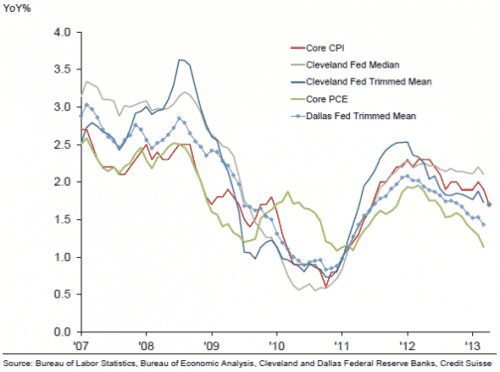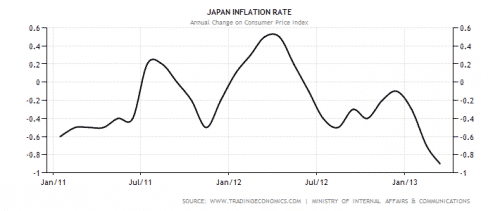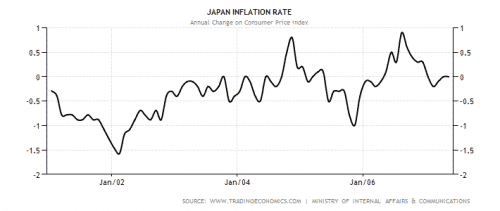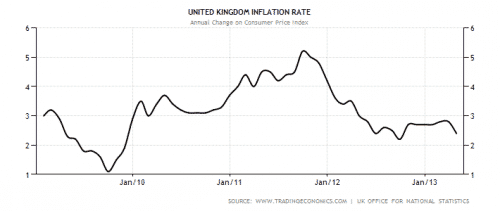On QE, inflation and Deflation
Well, in the US, anyway:
What is curious is that the US is doing QE. Lots of it. Which is supposed to raise inflation, isn’t it?
Then there is Japan. Japan recently embarked on an extensive QE programme designed to raise inflation to 2%. Here’s the path of Japanese inflation:
It’s very easy to see where QE started. It’s when inflation fell off a cliff. Well, ok, it might have done that anyway, I suppose. Correlation doesn’t equal causation, and all that. But it is curious.
Japan has, of course, done QE before. A look at the inflation path for the period 2001-2006, when Japan was doing QE, doesn’t suggest a close relationship between QE and inflation.
The initial impact seems to have been deflation, though again we could do with a counterfactual. But for the rest of the period QE seems to have had little impact on inflation. In fact a researcher at the IMF concluded that QE’s effect on inflation was small.
The UK does appear to buck the trend, since it experienced above-target inflation ever since commencing its QE programme, still the largest in the world relative to GDP although it is currently suspended. Though it is interesting that throughout 2012, when the Bank of England was doing QE, CPI was falling – it picked up in November 2012 when QE stopped:
But this isn’t quite what it appears. The UK’s CPI was pushed up by tax rises, student tuition fee increases (what on EARTH are they doing in measures of CPI anyway?) and above-inflation rises in near-monopoly privatised utilities which are subject to government price controls. Yes, really. Government not only allowed those above-inflation rises, it encouraged them in the name of investment – though why it thinks utilities should invest for the future now when it isn’t doing so itself is a mystery. And the other significant component of CPI in the UK is imports of essential items, notably oil. I suppose you could blame this on QE to some extent, because of its tendency to push up world commodity prices – but externally-driven cost-push inflation wasn’t exactly what was wanted, was it? Anyway, the poisonous combination of external factors and government mismanagement pushed inflation up while real incomes have been falling. How to squash domestic demand in one easy lesson…..the effect on retail sales, for example, is horrible.
When you strip those effects away from the UK’s CPI, it appears that inflation is dead there too. The Bank of England has been doing exactly this: it has “looked through” CPI to see the underlying deflationary trend. Not that it is planning any more QE at the moment. It is waiting to see how the Funding For Lending scheme works: this takes a different approach to reflating the economy involving new short-term government debt issuance rather than money – on the face of it a promising approach though to my mind it still relies far too much on damaged banks for its effects. But it seems the Bank is also thinking about negative rates.
Given the considerable evidence that QE does not raise core inflation in the countries doing it, it is a mystery to me why people are still talking as if it does. Bullard, for example, saying he thought the Fed’s QE programme should continue until inflation hit 2%. And the Bank of Japan supposedly targeting 2% inflation, though no-one really believes it (or do they? it seems “inflation expectations” in Japan are up….). And all the talk of inflation being a serious risk from QE exit, as if QE exit is going to happen any time soon. Yes, Bernanke is talking about “tapering off”. That isn’t exiting QE. It’s stopping it. Exiting QE (by which I mean returning the purchased assets to the private sector) is about as easy as ending capital controls and, like capital controls, will take years and years if it happens at all. And while inflation remains low there is no reason whatsoever to exit QE. If, in some future universe, inflation were to spike due to bank profligacy in the presence of enormous bank reserves, it is reasonable to suppose that inflation-targeting central banks would promptly drain those reserves by selling the purchased securities. Yes, I know the bond vigilantes dispute the existence of a market for such a large quantity of securities, but the private sector sold them in the first place, so why wouldn’t they buy them back? Really the idea of a buyers’ strike on central bank sales of securities makes no sense at all. The problem would be managing the pace of sales, taking into account impacts on inflation and on government finances.
So QE is NOT INFLATIONARY. Not now, and not ever. Let’s put a stake through the heart of the idea that central bank “recklessness”, as some people call it, will cause massive inflation.
The chart evidence above seems to show that if anything, QE has deflationary rather than inflationary effects. (yes, I know, correlation isn’t causation, counterfactual….). But it has been difficult to come up with a convincing explanation for this. This post is my first attempt. I do not pretend to have a complete answer, and for that reason I am creating an open space on the Coppola Comment blogsite where the debate can continue and people can pool information and ideas on this subject. We must find the answer….because if I am right, then QE is one of the biggest policy mistakes in history.
In my view the apparently deflationary impact of QE is due to what Stephen King calls its “unwanted redistributive effects”, so is an indirect rather than direct effect. As the Bank of England noted in its review of QE’s distributive effects, QE benefits the asset-rich at the expense of the income-dependent. To understand this, it is necessary to look at the context in which central banks do QE. The typical picture is of a stagnant economy with high unemployment, a high household savings rate (actual savings or debt deleveraging), risk-averse companies that are reluctant to invest, and – crucially – a damaged financial sector.
QE supports asset prices. Clearly, this most benefits those who own assets – who tend to be the rich and the old. In the aftermath of the 2008 financial crisis QE prevented catastrophic deleveraging and economic collapse: it was an emergency response to a desperate situation. But since then, the debate has moved on, the benefits of supporting asset prices now are by no means clear and there appear to be all manner of unintended consequences.
QE is supposed to nudge investors towards riskier investments by raising the price of safer ones. And it is succeeding in this: bond prices are at an all-time high and the stock market is reaching for the moon. This is supposed to reduce the cost of investment for those firms that can raise funds on the capital markets – i.e. larger companies. It doesn’t help small businesses who don’t have access to capital markets. That assistance was supposed to come through bank lending – but banks don’t want to lend to risky businesses at the moment. But it doesn’t seem that the reduction in borrowing costs for larger companies has encouraged them to invest for the future either. On the contrary, it seems they have been buying other assets….notably their own shares. There has been a swathe of share buy-backs in the corporate world, partly paid for with their extensive cash hoards and partly funded with cheap borrowing from the capital markets. Debt for equity swaps are all the rage. This does nothing whatsoever to improve growth, employment or income.
So we have a broken transmission mechanism. We often hear about a broken money transmission mechanism due to damaged banks, but we don’t often hear about a broken EMPLOYMENT transmission mechanism due to damaged corporates. Far from QE support of asset prices enabling companies to invest for the future and employ lots of people, it encourages them to indulge in financial jiggery-pokery to shore up their balance sheets and maintain directors’ incomes, while using high unemployment and government wage support systems as an excuse to force down wages. The sheer amount of spin from corporates about lack of investment opportunities is exceeded only by their constant moaning about quality of labour. You would think that the developed countries offer no opportunities for future profits, despite their skilled and flexible workforces and supportive infrastructure. And governments pander to this: they fund skills development programmes to compensate for the training that companies aren’t doing, they cut benefits to force people to take on more work – any work, however unsuited to their skill set and however badly paid – and they cut corporate taxes as yet more encouragement to invest and employ. Yet unemployment remains stubbornly high, productivity is poor and and hours of work are falling.
In the case of smaller businesses – and more generally in Europe, where businesses depend more on bank lending – the problem is the broken money transmission mechanism. The fact is that damaged banks won’t lend to riskier prospects, especially when they are under regulatory pressure to de-risk their balance sheets: interest rates on lending to small businesses remain high despite the considerable support extended to banks by governments in the developed world. QE has provided banks with huge amounts of excess reserves – but it hasn’t given them a reason to lend productively. As with corporates, QE simply gives banks an opportunity to shore up their balance sheets and maintain directors’ remuneration. Banks, too, tried to spin their lack of SME lending as due to a shortage of good quality opportunities – but NIESR’s recent research gave the lie to that.
So the broken financial and corporate transmission mechanisms mean that QE does not reflate the real economy. That alone would make it pretty ineffective. But it doesn’t make it actually deflationary. To understand why the fact that it encourages hoarding and risk-averse behaviour means deflation, we need to complete the loop from companies starved of investment to an economy starved of demand.*
It does not matter whether a company is starved of investment because banks won’t lend to it, or whether it starves itself of investment through exploiting QE-induced distortions in the financial markets. The effect is reduced productivity, which pushes through to reduced wages. If the cost of capital is such that using low-cost labour is cheaper than investing in machines, unemployment may fall, but so will productivity as workers have to use less efficient tools. Similarly, if it is cheaper to use poorly-paid temporary, part-time, casual and self-employed workers than to recruit full-time staff, unemployment will also fall – but average hours worked will also fall. In both the UK and US we are seeing increasing under-employment and reducing productivity: unemployment is high in both countries, but not as high as it might be if average hours worked were higher. For me this indicates a pattern of low corporate investment in both capital and people.
Under-employment and falling productivity force down real incomes. Add to this the effects of fiscal tightening in both the UK and the US, which hit working people on middle to low incomes disproportionately, and to my mind you have a significant hit to aggregate demand which is sufficient to explain deflation in both countries. Both UK and US governments believe that monetary tools such as QE can offset the contractionary impact of fiscal tightening. But this is wrong. Fiscal tightening principally affects those who live on earned income. QE supports asset prices, but it does nothing to support incomes. So QE cannot possibly offset the effects of fiscal tightening in the lives of ordinary working people – the largest part of the population. In fact because it seems to discourage productive corporate investment, it may even reinforce downwards pressure on real incomes. And when the real incomes of most people fall, so does demand for goods and services, which puts downward pressure on prices, driving companies to reduce costs by cutting hours, wages and jobs. This form of deflation is a vicious feedback loop between incomes, sales and consumer prices, which in my view propping up asset prices can do little to prevent.
Ah, you say, but most people own assets, don’t they – through their pensions and in the form of houses. This is true. And it is fair to say that QE props up the value of both pension investments and real estate. But it depresses returns on savings.** Depressing returns is supposed to encourage people to spend instead of save. But when people are saving for their old age, and they see their savings whittled away in the form of below-inflation returns, they are likely to save MORE, not less. They will cut discretionary spending to increase pension saving. This I think is partly the cause of the apparently deflationary effect of QE in Japan. Japan’s households have high savings rates because they have to save for retirement as there is no state safety net. In the US and UK the effect may be less, because both these countries have substantial state pension & benefits provision for the elderly. But….those schemes are unfunded, and future taxation may be unable to support claims on those schemes. Therefore governments persistently “talk up” the need to save for old age. It seems likely, therefore, that the combination of increased pressure to save for retirement and depression of returns on savings is encouraging people in the US and UK to increase savings at the expense of discretionary spending too. Once again it seems that the combination of QE with other things is deflationary, though that doesn’t necessarily mean QE itself is.
Then there is real estate. Homeowners benefit from Government propping house prices with various forms of QE. This support is explicit in the US at the moment, since the Fed is buying agency MBS, though perhaps less obvious in the UK. But QE supports real estate prices even if only government debt is purchased. The rising price of safe assets pushes investors not just towards riskier investments, but also towards safer ones….most notably prime real estate, which has risen considerably in value. Supporting house prices through QE, coupled with low rate policies that (especially in the UK) have kept mortgage rates for existing borrowers very low, has prevented mortgage defaults and supported aggregate demand. But there is a cost. Rental values are high, which hurts people who don’t own property – the young, and people on low incomes. There is little evidence now of wealth effects from property prices increasing spending, as used to be the case prior to the financial crisis: people simply aren’t taking out second mortgages to release equity for consumer spending at the moment. Fingers have been well and truly burned, and uncertainty around jobs and income means that people are reluctant to take on more borrowing….after all, if your income is falling and/or uncertain, servicing debt is a constant worry, and taking on more (unless you have to) is madness.
Overall, therefore, QE looks deflationary to me. Or if not actually deflationary in itself, at least completely ineffective as an offset to contractionary fiscal policy and fear-driven hoarding by companies and households. And there is one particularly poisonous effect that I mentioned in passing earlier in this post. The excess liquidity caused by QE, and shortages of the safe assets being purchased, encourages investors not only into riskier assets, but also into alternative safe ones. There is a lot of cash hoarding going on…..and I’ve noted already that QE drives up the price of prime real estate. It also interferes with the pricing of metals, which has implications for production costs in manufacturing industries. And spikes in the prices of foodstuffs and oil have also been attributed to QE. If this is true, then QE is toxic, because it increases the price of the essential goods that people need in order to live. But as with all things QE-related, it’s not that simple….after all, commodity prices are falling at the moment. What is clear, though, is that QE causes enormous distortions in financial markets which are not fully understood and which create fear, uncertainty and instability in the financial system. This could be justified if its effects were evidently beneficial. But it is by no means clear that they are.
From where I stand, QE looks like a very bad bet indeed. The benefits are uncertain and the downside risks huge. In my view it should be stopped. But you may not agree – and I know that many people are much more positive about QE. If you believe that overall its effects are beneficial to the economy, please do comment. Or even submit a post of your own arguing the opposite case.
And here is a final thought. It’s all very well criticising QE, but what should we do instead? After all, we have stagnant economies, damaged banks, risk-averse corporates, highly-indebted households, high unemployment, under-employment, low productivity and falling real incomes. Doing nothing is not an option. If QE is a disaster, what is the alternative?
Related links:
Inflation is falling everywhere – FT Alphaville
Measure it however you like, inflation has been low and falling – FT Alphaville
Estimates of inflation expectations – Cleveland Fed (h/t Izabella Kaminska)
Bank of Japan’s quantitative and credit easing: are they now more effective? – Berkman (IMF)
UK retail sales commentary May 2013 – Markit
The fatally flawed FLS – Coppola Comment
UK Treasury Committee oral evidence on QE – Gavyn Davies, Stephen King and Roger Farmer
Electronic money and negative rates – Pieria
The distributional effects of asset purchases – Bank of England
Lessons at the zero bound: the Japanese and US experience – Bernanke (NY Fed)
Executives cash in as cheap debt funds staff buybacks – FT (paywall)
Evaluating changes in bank lending to SMEs 2001-12 – NIESR
Bifurcation in the labour market – Coppola Comment
The financialisation of labour – Pieria
Bank of England must halt QE gilt-buying – Saga
John Cochrane outlines a different argument for the contractionary effects of QE in The Fed and Shadow Banking.
John Aziz recently suggested an alternative to QE.
* We should remember of course that we do not live in a closed world, but the US and UK both have substantial trade deficits and Japan has slipped into trade deficit too. Since the entire world is attempting to increase exports and reduce imports at the moment, it seems highly unlikely that the export sector can make up for lack of domestic demand…..especially since Japan’s economy has stagnated for 20 years DESPITE a significant trade surplus for much of that time. I don’t think an export-led recovery is really possible for anyone. Domestic demand is the key to recovery.
** Campaigners for the elderly claim that people who are living on the returns from their savings are finding their incomes squeezed because of QE. Some are compensating for this by taking on part-time work, but others are simply cutting spending. This is an obvious hit to demand, although this is a relatively small group of people so the deflationary effect would be small. But I am not convinced that this is a major cause of QE’s deflationary effects: I agree with the Bank of England that the main cause of the squeeze on fixed incomes is low rates. The distributional impact of QE is far more complex.




Comments are closed.